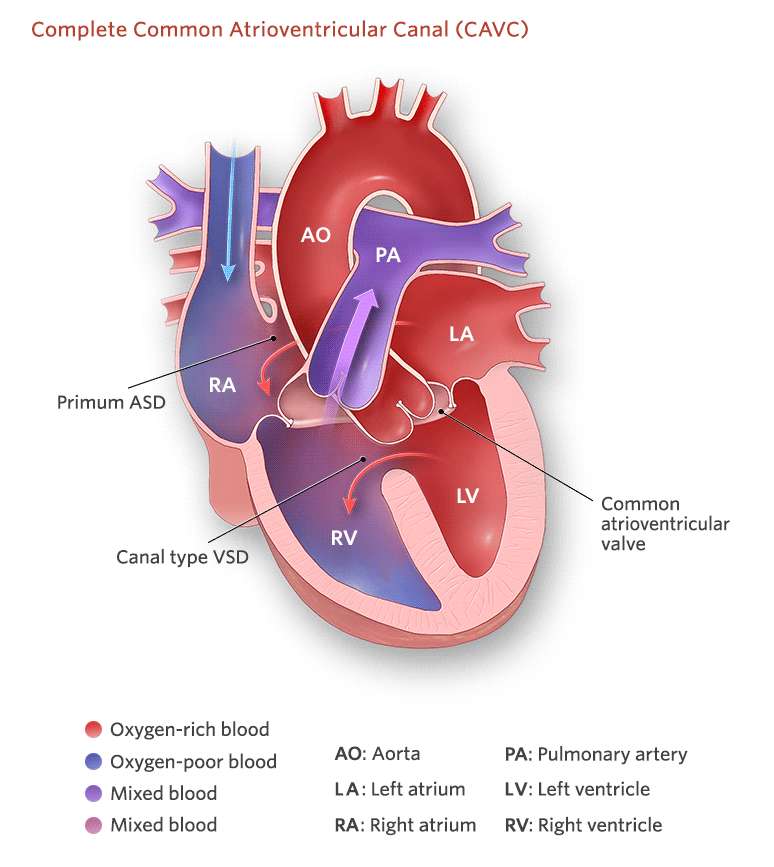
What are atrioventricular septal defects?
An atrioventricular canal (AVC) defect is a problem in the part of the heart that connects the upper chambers (atria) to the lower chambers (ventricles). There are two types of atrioventricular canal defects: complete and partial.
Complete atrioventricular septal defect (AVSD)
Complete atrioventricular canal (AVSD) is a severe form of congenital heart defect. Following defects are seen with it
1) a large hole in the tissue (the septum) that separates the left and right sides of the heart. The hole is in the center of the heart, where the upper chambers (the atria) and the lower chambers (the ventricles) meet.
2) valves that separate the upper and lower chambers also developed abnormally. Instead of 2 valves, there is one large valve which is frequently leaky. As a result of the abnormality, blood from both sides mixes. There is excessive blood flowing to lungs.
Partial atrioventricular canal defects : Primum atrial septal defect
It is less severe form of this heart defect. The hole is limited to upper chamber and does not extend between the lower chambers of the heart. There are 2 valves but they are generally leaky.
Signs and symptoms of AVSD defects
In a complete AVSD, the following symptoms may be present within several days or weeks of birth:
- Difficulty breathing
- Poor weight gain and growth
- Heart murmur: abnormal heart sound
Partial AVSD defects cause fewer symptoms and sometimes aren’t diagnosed until the child reaches adulthood. Then, he or she may begin to experience symptoms which are 1) fatigability, 2) breathlessness.
Testing and diagnosis
Paediatricians hear abnormal heart sound during general evaluation an refer them to paediatric cardiologist for further evaluation. Sometimes a complete atrioventricular canal defect is diagnosed on a fetal echocardiogram.
Diagnosis of atrioventricular canal defects may require some or all of these tests:
- Fetal echo: AVSD can be diagnosed in mother’s womb before birth. Sometimes complete AVSD is associated with other complex cardiac and non cardiac anomalies. Thorough discussion with parents about nature of defect is the way ahead.
- 2D echocardiogram: it gives detail idea about nature, severity and complications related to disease.
- Electrocardiogram (ECG): a record of the electrical activity of the heart
- Chest X-ray
- Pulse oximetry:
- Cardiac catheterization: Infrequently used to asses pulmonary pressure in a selected cases.
Treatment for atrioventricular canal defects
Complete atrioventricular canal defects require surgery, usually within the first few months of life. The surgeon will close the large hole with one or two patches. The single large valve is separated into two valves, and sometimes they need repairs.
Surgery is the treatment for partial atrioventricular canal defects irrespective of age of patient, ie. both child or adult. The hole in heart is closed with patch and leaky valves are repaired.
Post surgery patients are kept in ICU for recovery.
Outlook and long term follow up:
After surgery, most children recover completely and won’t need additional surgery or procedures. There are some unique long term problems observed like
- leaky or small valve
- obstruction to blood flow out of heart (LVOTO),
- Arrhythmia etc.
Long term follow up with paediatric cardiologist is mandatory to diagnose these problems well in time. If there are any, they can be resolved with help of additional surgery or catheterization.

REPLY COMMENT